Multilayer Circuit Board And Method Of Manufacturing The Same
HU; XIAN-QIN ; et al.
U.S. patent application number 16/255236 was filed with the patent office on 2019-09-19 for multilayer circuit board and method of manufacturing the same. The applicant listed for this patent is Avary Holding (Shenzhen) Co., Limited., HongQiSheng Precision Electronics (QinHuangDao) Co ., Ltd.. Invention is credited to MING-JAAN HO, XIAN-QIN HU, YAN-LU LI, LI-KUN LIU.
| Application Number | 20190289725 16/255236 |
| Document ID | / |
| Family ID | 67904310 |
| Filed Date | 2019-09-19 |
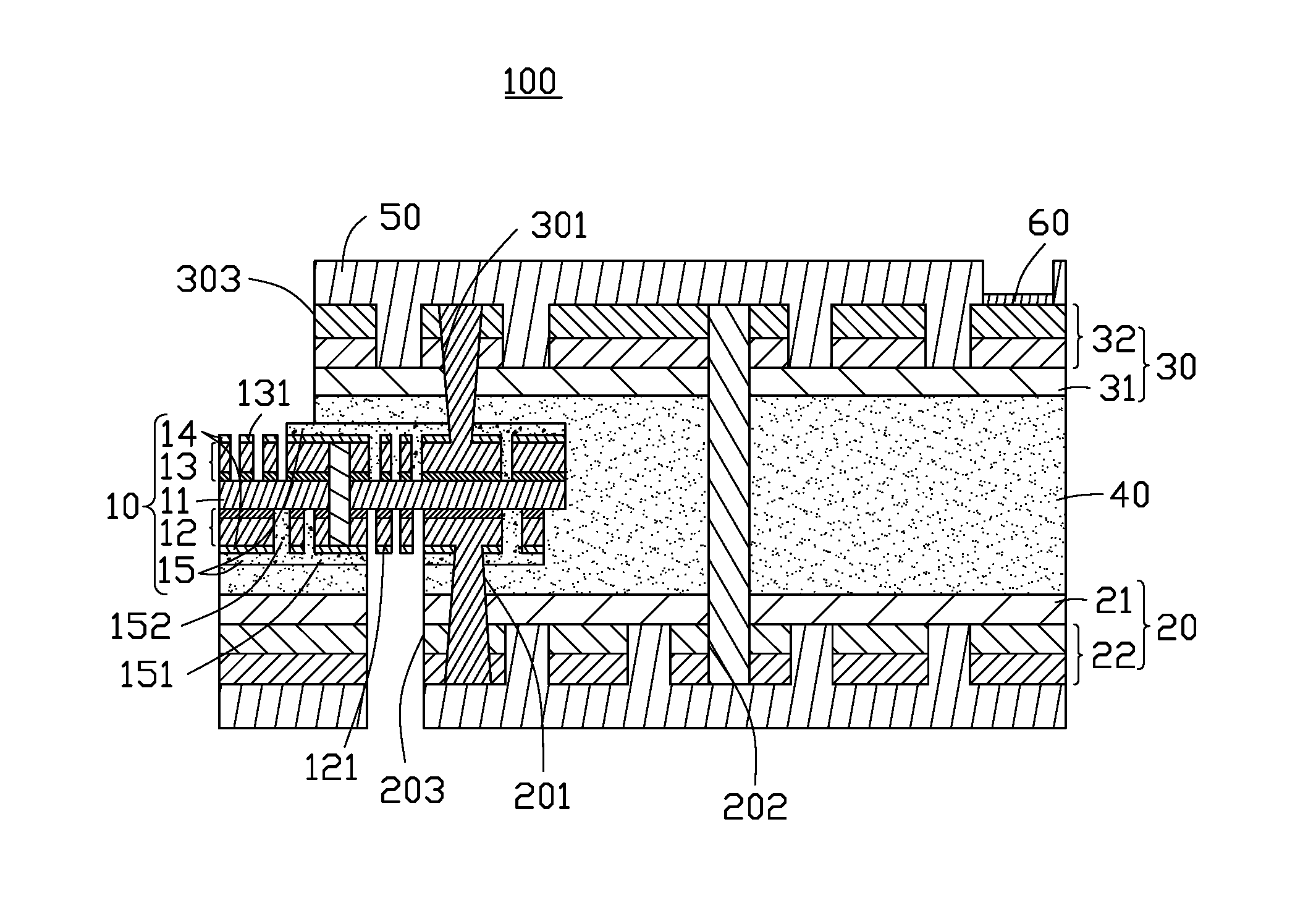
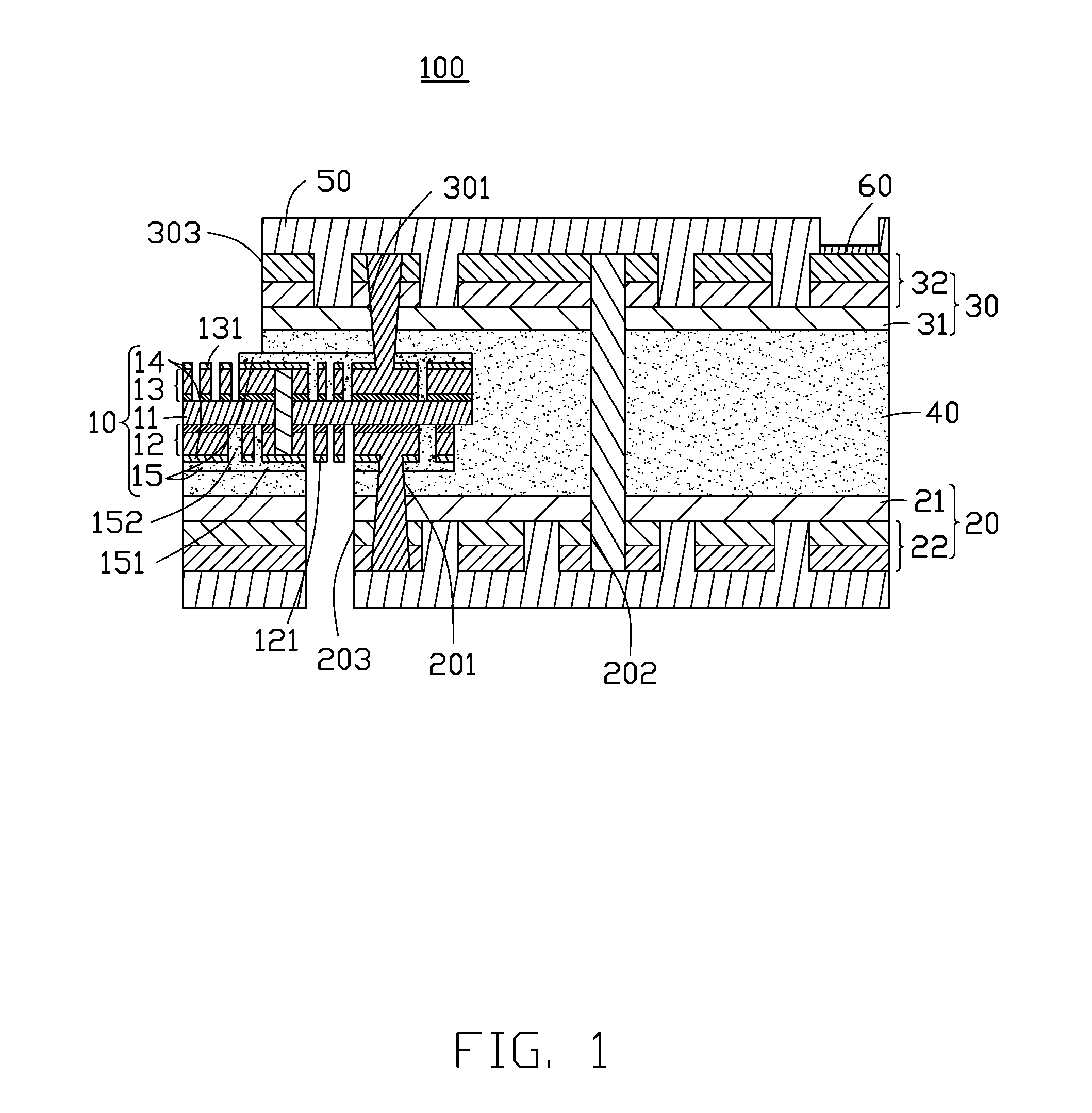
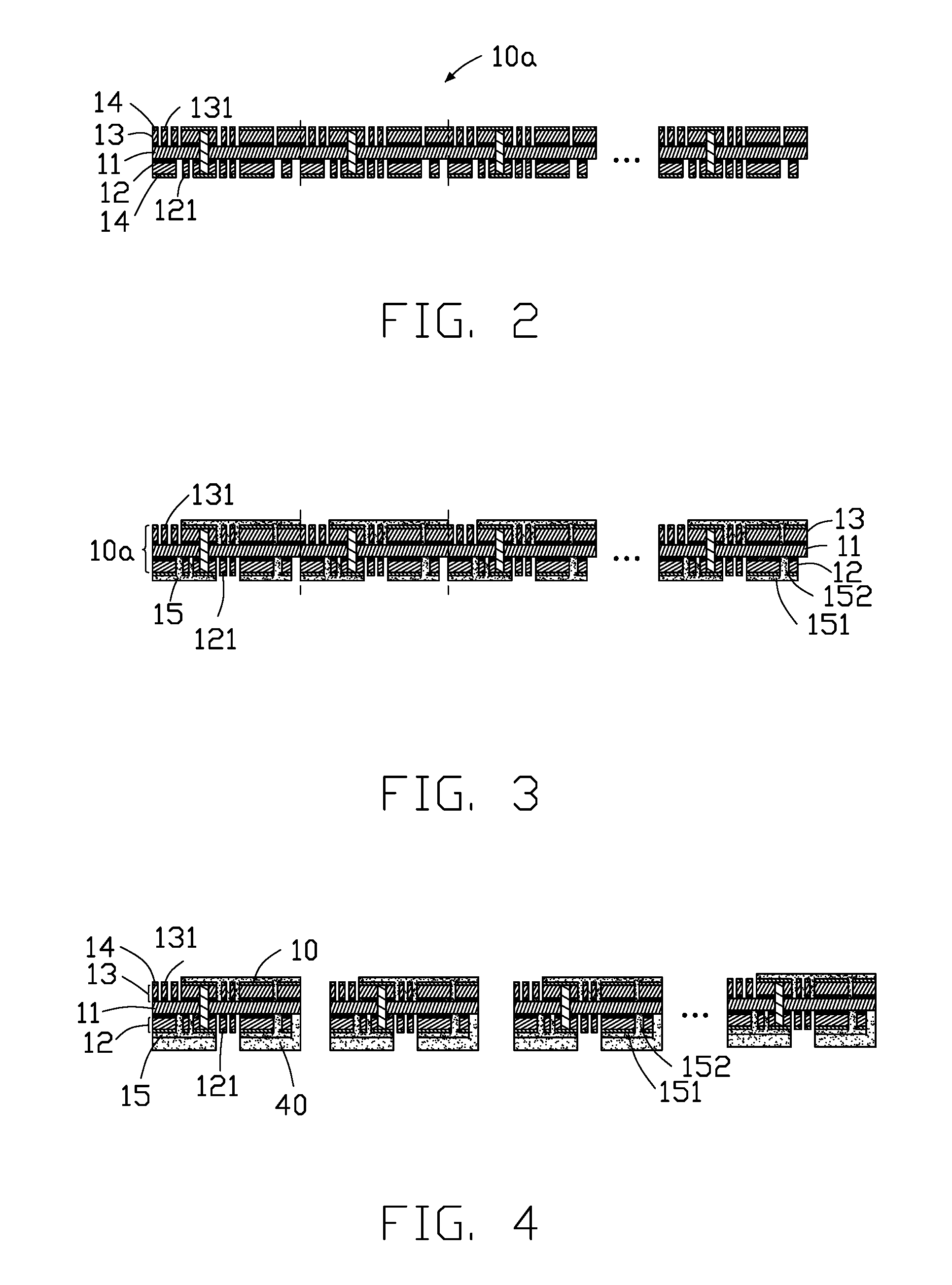

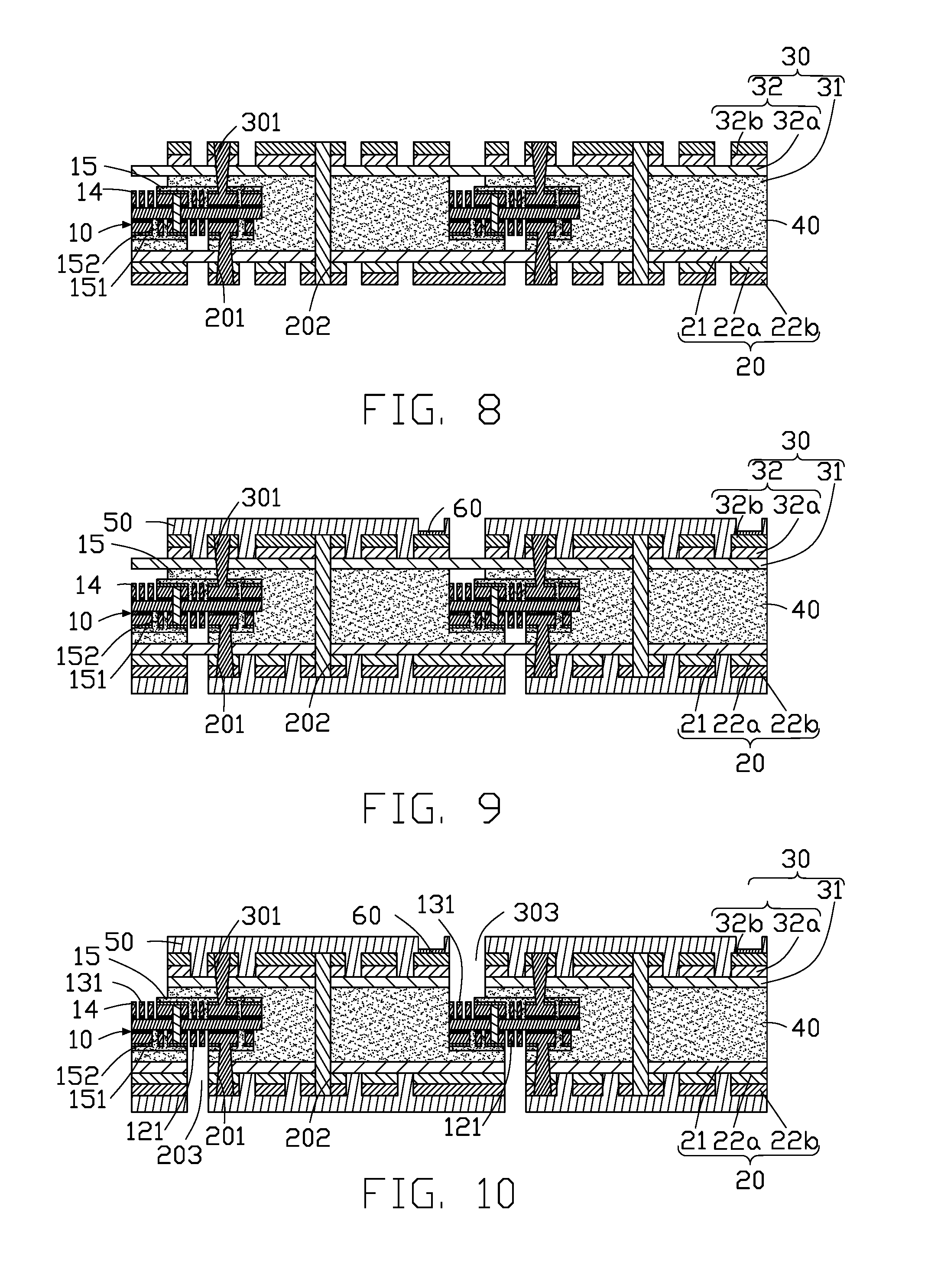
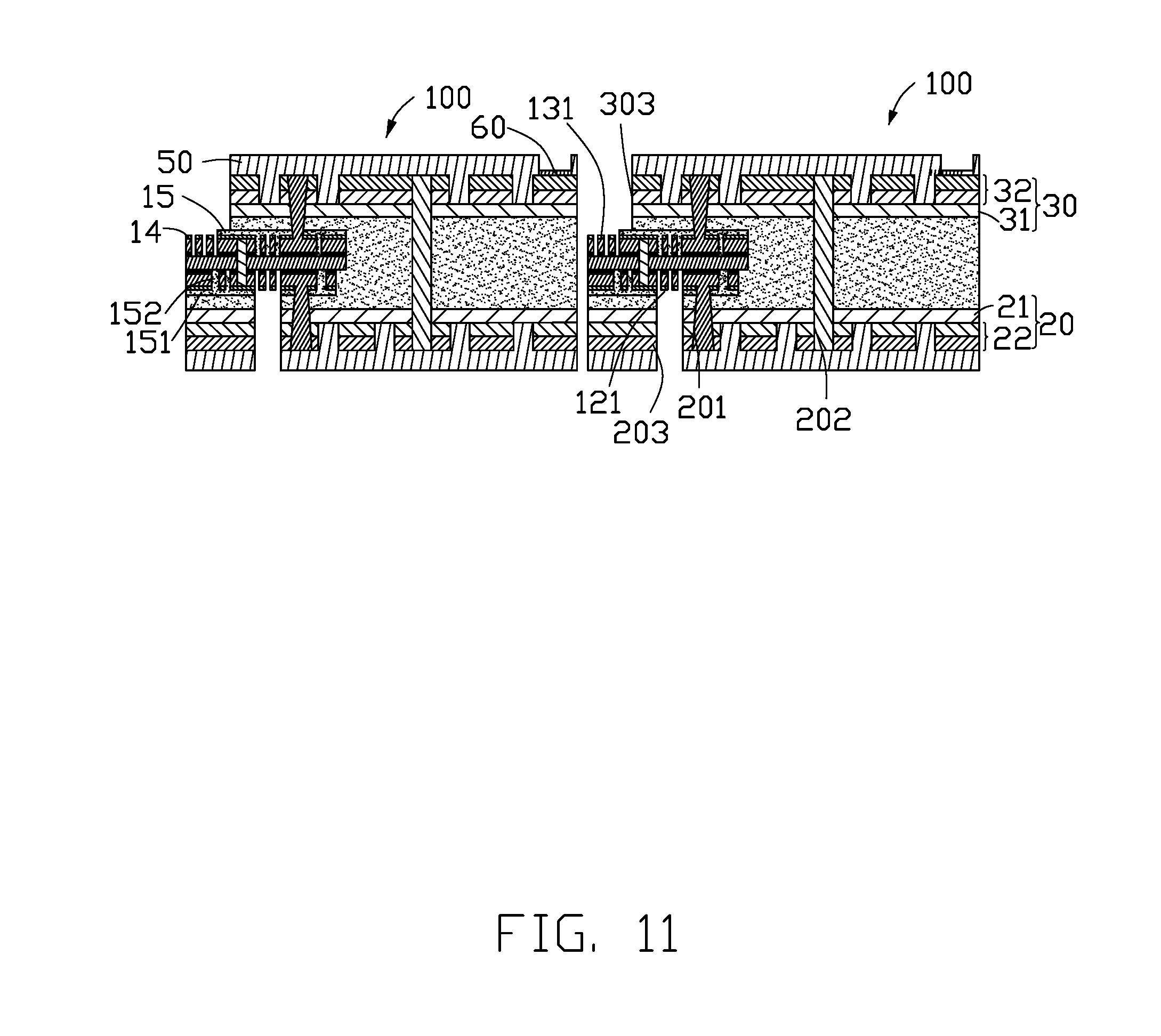
| United States Patent Application | 20190289725 |
| Kind Code | A1 |
| HU; XIAN-QIN ; et al. | September 19, 2019 |
MULTILAYER CIRCUIT BOARD AND METHOD OF MANUFACTURING THE SAME
Abstract
A multilayer circuit board comprises an inner circuit unit having at least one solder portion, and at least one outer circuit board coupled with the inner circuit unit. The inner circuit unit connects with the outer circuit board by an insulation colloid. At least one side of the inner circuit unit does not extend to edges of the multilayer circuit board. The at least one outer circuit board forms at least one through-hole and at least one conductive hole. The at least one conductive hole which is internally-plated with copper extends from the at least one outer circuit board to the inner circuit unit. A method of manufacturing the multilayer circuit board is also disclosed.
| Inventors: | HU; XIAN-QIN; (Qinhuangdao, CN) ; LIU; LI-KUN; (Qinhuangdao, CN) ; LI; YAN-LU; (Qinhuangdao, CN) ; HO; MING-JAAN; (New Taipei, TW) | ||||||||||
| Applicant: |
|
||||||||||
|---|---|---|---|---|---|---|---|---|---|---|---|
| Family ID: | 67904310 | ||||||||||
| Appl. No.: | 16/255236 | ||||||||||
| Filed: | January 23, 2019 |
Related U.S. Patent Documents
| Application Number | Filing Date | Patent Number | ||
|---|---|---|---|---|
| 15957875 | Apr 19, 2018 | |||
| 16255236 | ||||
| Current U.S. Class: | 1/1 |
| Current CPC Class: | H05K 2201/09063 20130101; H05K 2201/10378 20130101; H05K 3/285 20130101; H05K 2201/058 20130101; H05K 1/189 20130101; H05K 3/4635 20130101; H05K 1/0278 20130101; H05K 3/06 20130101; H01L 23/49822 20130101; H05K 3/4697 20130101; H01L 23/49827 20130101; H05K 1/186 20130101; H05K 2203/0228 20130101; H05K 3/429 20130101; H01L 21/4857 20130101; H05K 3/0052 20130101; H05K 2201/09509 20130101; H05K 1/115 20130101; H05K 3/42 20130101; H01L 21/481 20130101; H05K 3/4602 20130101; H01L 23/4985 20130101 |
| International Class: | H05K 3/46 20060101 H05K003/46; H01L 23/498 20060101 H01L023/498; H05K 1/11 20060101 H05K001/11; H05K 1/18 20060101 H05K001/18; H01L 21/48 20060101 H01L021/48; H05K 3/28 20060101 H05K003/28; H05K 3/42 20060101 H05K003/42; H05K 3/00 20060101 H05K003/00 |
Foreign Application Data
| Date | Code | Application Number |
|---|---|---|
| Mar 16, 2018 | CN | 201810218827.8 |
Claims
1. A multilayer circuit board, comprising: an inner circuit unit comprising at least one solder portion; and at least one outer circuit board coupled with the inner circuit unit; wherein the inner circuit unit connects with the at least one outer circuit board by an insulation colloid, at least one side of the inner circuit unit does not extend to edges of the multilayer circuit board, the at least one outer circuit board forms at least one through-hole and at least one conductive hole, the at least one solder portion is expose to the at least one through-hole, the conductive hole extends from the at least one outer circuit board to the inner circuit unit, and the conductive hole is plated with metal for connecting electrically with the at least one outer circuit board and the inner circuit unit.
2. The multilayer circuit board of claim 1, wherein the inner circuit unit comprises an insulation layer, a first inner conductive layer and a second inner conductive layer formed on opposite sides of the insulation layer.
3. The multilayer circuit board of claim 2, wherein the solder portion comprises a first solder portion formed on the first inner conductive layer and a second solder portion formed on the second inner conductive layer.
4. The multilayer circuit board of claim 3, wherein the outer circuit board comprises a first outer circuit board coupled with the first inner conductive layer and a second outer circuit board coupled with the second inner conductive layer.
5. The multilayer circuit board of claim 4, wherein the through-hole comprises a first through-hole formed on the first outer circuit board and a second through-hole formed on the second outer circuit board, the first solder portion is exposed to the first through-hole, the second solder portion is exposed to the second through-hole.
6. The multilayer circuit board of claim 4, wherein the conductive hole comprises a first conductive hole and a second conductive hole formed on the first outer circuit board, and a third conductive hole formed on the second outer circuit board.
7. The multilayer circuit board of claim 6, wherein the first conductive hole extends from the first outer circuit board to the first inner conductive layer of the inner circuit unit, the second conductive hole extends through the first outer circuit board, the insulation colloid and the second outer circuit board, the third conductive hole is corresponding to the first conductive hole and extends from the second outer circuit board to the second inner conductive layer of the inner circuit unit.
8. The multilayer circuit board of claim 2, wherein the inner circuit unit further comprises a first protection layer, the first protection layer is formed on an outer surface of the first inner conductive layer and an outer surface of the second inner conductive layer.
9. The multilayer circuit board of claim 8, wherein the inner circuit unit further comprises a first covering layer, the first covering layer comprises a main portion and a plurality of extending portion, the main portion is formed on an outer surface of the first protection layer, the plurality of extending portions extend vertically from the main portion to the first inner conductive layer and the second inner conductive layer.
10. The multilayer circuit board of claim 4, wherein the multilayer circuit further comprises a second covering layer and a second protection layer, the second covering layer and the second protection layer are formed on an outer surface of the first outer circuit board and an outer surface of the second outer circuit board.
Description
CROSS-REFERENCE TO RELATED APPLICATIONS
[0001] This application is a divisional application of a commonly-assigned application entitled "MULTILAYER CIRCUIT BOARD AND METHOD OF MANUFACTURING THE SAME", filed on 2018 Apr. 19 with application Ser. No. 15/957,875. The disclosure of the above-identified application is incorporated herein by reference.
FIELD
[0002] The subject matter herein generally relates to a circuit, especially relates to a multilayer circuit board and method of manufacturing the same.
BACKGROUND
[0003] Electronic devices are becoming thinner with bigger screens. So Chip On Flex (COF) with fine lines and good flexible is widely used in the electronic device. COF is difficult to connect with Surface Mount Technology (SMT). The COF can be combined with at least one flexible circuit board, and when the COF is combined with a flexible circuit board, the COF is manufactured to have a size correspondingly to the flexible board. However, the COF has only some of the fine conductive lines coupled with the flexible circuit board. The COF in this usage thus has a lower use ratio when combined with the flexible circuit.
BRIEF DESCRIPTION OF THE DRAWINGS
[0004] Many aspects of the disclosure can be better understood with reference to the following drawings. The components in the drawings are not necessarily drawn to scale, the emphasis instead being placed upon clearly illustrating the principles of the disclosure. Moreover, in the drawings, like reference numerals designate corresponding parts through the several views.
[0005] FIG. 1 is a cross-sectional view of a multilayer circuit board of the present disclosure.
[0006] FIGS. 2-11 are cross-sectional views of illustrating a multilayer circuit board, illustrating respective steps of a method of manufacturing the same in according with the multilayer circuit board of FIG. 1.
DETAILED DESCRIPTION OF EMBODIMENTS
[0007] It will be appreciated that for simplicity and clarity of illustration, numerous specific details are set forth in order to provide a thorough understanding of the embodiments described herein. However, it will be understood by those of ordinary skill in the art that the embodiments described herein can be practiced without these specific details. In other instances, methods, procedures and components have not been described in detail so as not to obscure the related relevant feature being described. The drawings are not necessarily to scale and the proportions of certain parts have been exaggerated to better illustrate details and features of the present disclosure. The description is not to be considered as limiting the scope of the embodiments described herein.
[0008] Several definitions that apply throughout this disclosure will now be presented. The term "comprising" means "including, but not necessarily limited to"; it specifically indicates open-ended inclusion or membership in a so-described combination, group, series and the like. The term "coupled" is defined as connected, whether directly or indirectly through intervening components, and is not necessarily limited to physical connections. The connection can be such that the objects are permanently connected or releasably connected.
[0009] Referring to FIG. 1, the multilayer circuit board 100 of the present disclosure includes an inner circuit unit 10, a first outer circuit board 20 and a second outer circuit board 30. The inner circuit unit 10 connects with the first outer circuit board 20 and the second outer circuit board 30 by an insulation colloid 40.
[0010] In an embodiment, the inner circuit unit 10 is a COF. The first outer circuit board 20 and the second outer circuit board 30 are flexible circuit boards.
[0011] The inner circuit unit 10 can be coupled with an end of the first outer circuit board 20 on one side and an end of the second outer circuit board 30 on the opposite side. At least one side of the inner circuit unit 10 does not extend to edges of the multilayer circuit board 100.
[0012] The inner circuit unit 10 includes an insulation layer 11, a first inner conductive layer 12 and a second inner conductive layer 13. The first inner conductive layer 12 and the second inner conductive layer 13 can be formed on opposite sides of the insulation layer 11. The first inner conductive layer 12 and the second inner conductive layer 13 can be metal. In an embodiment, the first inner conductive layer 12 and the second inner conductive layer 13 are made of copper.
[0013] The first inner conductive layer 12 forms at least one first solder portion 121. The second inner conductive layer 13 forms at least one second solder portion 131. The first solder portion 121 is exposed to the first outer circuit board 20. The second solder portion 131 is exposed to the second outer circuit board 30.
[0014] The inner circuit unit 10 further includes a first protection layer 14. The first protection layer is formed on an outer surface of the first inner conductive layer 12 and an outer surface of the second inner conductive layer 13. Thus, the first protection layer 14 covers the first inner conductive layer 12 and the second inner conductive layer 13. The first protection layer 14 can prevents the first solder portion 121 and the second solder portion 131 from oxidizing and increases a reliability of the inner circuit unit 10. In the embodiment, the first protection layer 14 is made of the tin.
[0015] Further, the inner circuit unit 10 includes a first covering layer 15. The first covering layer 15 includes a main portion 151 and a plurality of extending portions 152. The main portion 151 is formed on an outer surface of the first protection layer 14. The plurality of extending portions 152 extend vertically from the main portion 151 to the first inner conductive layer 12 and the second inner conductive layer 13.
[0016] The first outer circuit board 20 includes a first insulation layer 21 and a first outer circuit layer 22 formed on a side of the first insulation layer 21. The insulation colloid 40 connects the first insulation layer 21 and the first inner conductive layer 12.
[0017] Further, the first outer circuit board 20 forms a first conductive hole 201 and a second conductive hole 202. The first conductive hole 201 extends from the first outer circuit board 20 to the first inner conductive layer 12 of the inner circuit unit 10. The second conductive hole 202 extends through the first outer circuit board 20, the insulation colloid 40 and the second outer circuit board 30. The inner circuit unit 10 is located on one side of the second conductive hole 202.
[0018] Further, the first outer circuit board 20 forms a first through-hole 203. The first solder portion 121 is exposed to the first through-hole 203.
[0019] The second outer circuit board 30 includes a second insulation layer 31 and a second outer circuit layer 32 formed on a side of the second insulation layer 31. The insulation colloid 40 connects with the second insulation layer 31 and the second inner conductive layer 13.
[0020] The second outer circuit board 30 forms a third conductive hole 301 corresponding to the first conductive hole 201. The third conductive hole 301 extends from the second outer circuit board 30 to the second inner conductive layer 13 of the inner circuit unit 10.
[0021] Further, the first conductive hole 201, a second conductive hole 202 and the third conductive hole 301 are plated with metal for connecting electrically with the inner circuit unit 10, the first outer circuit board 20 and the second outer circuit board 30. In an embodiment, the metal is copper.
[0022] Further, the second outer circuit board 30 forms a second through-hole 303. The second solder portion 131 is exposed to the second through-hole 303.
[0023] Further, the multilayer circuit board 100 includes a second covering layer 50 and a second protection layer 60. The second covering layer 50 and the second protection layer 60 are formed on an outer surface of the first outer circuit board 20 and an outer surface of the second outer circuit board 30. The second covering layer 50 and the second protection layer 60 protect the first outer circuit board 20 and the second outer circuit board 30 from oxidizing and enhances a stability of the multilayer circuit board 100. In the embodiment, the second covering layer 50 is made of CVL, PiCL or ink etc. The second protection layer 60 is made of gold.
[0024] Referring to FIGS. 2-11, a method for manufacturing the multilayer circuit board 100 includes the following steps:
[0025] First step, referring to FIG. 2, providing an inner circuit board 10a and forming a first protection layer 14 on the outer surface of the inner circuit board 10a.
[0026] The inner circuit board 10a includes an insulation layer 11, and a first inner conductive layer 12 and a second inner conductive layer 13 formed on opposite sides of the insulation layer 11. The first inner conductive layer 12 forms at least one first solder portion 121. The second inner conductive layer 13 forms at least one second solder portion 131. The first protection layer 14 covers the first inner conductive layer 12 and the second inner conductive layer 13. In the embodiment, the first protection layer 14 is made of the tin.
[0027] Second step, referring to FIG. 3, forming a first covering layer 15 on the first protection layer 14.
[0028] The first covering layer 15 includes a main portion 151 and a plurality of extending portions 152. The main portion 151 is formed on an outer surface of the first protection layer 14. The plurality of extending portions 152 extend vertically from the main portion 151 to the first inner conductive layer 12 and the second inner conductive layer 13.
[0029] Third step, referring to FIG. 4, covering a side of the inner circuit board 10a with an insulation colloid 40, and cutting the inner circuit board 10a into multiple inner circuit units 10.
[0030] Generally, the insulation colloid 40 is on the first inner conductive layer 12 of the inner circuit unit 10. The first solder portion 121 is exposed from the insulation colloid 40.
[0031] Fourth step, referring to FIG. 5, providing a first outer substrate 20a, and pasting the inner circuit unit 10 on the outer substrate 20a by the insulation colloid 40.
[0032] The first outer substrate 20a includes a first insulation layer 21 and a first outer conductive layer 22a formed on a side of the first insulation layer 21. The insulation colloid 40 connects the first inner conductive layer 12 of the inner circuit unit 10 and the first insulation layer 21 of the first outer substrate 20a.
[0033] Fifth step, referring to FIG. 6, providing a second outer substrate 30a and pasting the outer substrate 30a on another side of the inner circuit unit 10 by the insulation colloid 40.
[0034] The second outer substrate 30a includes a second insulation layer 31 and a second outer conductive layer 32a formed on the second insulation layer 31. The insulation colloid 40 connects the second inner conductive layer 13 of the inner circuit unit 10 and the second insulation layer 31 of the outer substrate 30a. The insulation colloid 40 further covers the first inner circuit unit 10 and fills the space defined between the first outer substrate 20a and the second outer substrate 30a. The second solder portion 131 is exposed from the insulation colloid 40.
[0035] Sixth step, referring to FIG. 7, electrically coupling the inner circuit unit 10, the first outer substrate 20a, and the second outer substrate 30a.
[0036] In an embodiment, the first outer substrate 20a forms a first conductive hole 201 and a second conductive hole 202. The second outer substrate 30a forms a third conductive hole 301 corresponding to the first conductive hole 201. The first conductive hole 201 extends from the first outer substrate 20a to the first inner conductive layer 12 of the inner circuit unit 10. The second conductive hole 202 extends through the first outer substrate 20a, the insulation colloid 40, and the second outer substrate 30a. The third conductive hole 301 extends from the second outer substrate 30a to the second inner conductive layer 13 of the inner circuit unit 10. The first conductive hole 201, a second conductive hole 202 and the third conductive hole 301 are internally plated with copper. A first copper foil 22b is formed on an outer surface of the first outer substrate 20a. A second copper foil 32b is formed on an outer surface of the second outer substrate 30a. The first outer substrate 20a is coupled with the inner circuit unit 10 by the internally-plated first conductive hole 201. The first outer substrate 20a is coupled with the second outer substrate 30a by the internally-plated second conductive hole 202. The second outer substrate 30a is coupled with the inner circuit unit 10 by the internally-plated third conductive hole 301. It can be understood that electrically coupling of the inner circuit unit 10 the first outer substrate 20a and the second outer substrate 30a is by conductive paste.
[0037] Seventh step, referring to FIG. 8, etching the first outer substrate 20a and the second outer substrate 30a to form a first outer circuit board 20 and a second outer circuit board 30.
[0038] Generally, the first outer circuit board 20 is formed by etching the first outer conductive layer 22a and the first copper foil 22b. The first outer circuit board 20 includes the first insulation layer 21 and the first outer circuit layer 22 making up the first conductive layer 22a and the first copper foil 22b. The second outer circuit board 30 is formed by etching the second outer conductive layer 32a and the second copper foil 32b. The second outer circuit board 30 includes the second insulation layer 31 and the second outer circuit layer 32 making up of the second outer conductive layer 32a and the second copper foil 32b.
[0039] Eighth step, referring to FIG. 9, forming a second covering layer 50 and a second protection layer 60 on an outer surface of the first outer circuit board 20 and an outer surface of the second outer circuit board 30.
[0040] In the embodiment, the second covering layer 50 is made of CVL, PiCL or ink etc. The second protection layer 60 is made of gold.
[0041] Ninth step, referring to FIG. 10, forming a first through-hole 203 on the first outer circuit board 20 to expose the first solder portion 121, and forming a second through-hole 303 on the second outer circuit board 30 to expose the second solder portion 131.
[0042] Tenth step, referring to FIG. 11, vertically cutting the second outer circuit board 30 and the first outer circuit board 20 to achieve multiple multilayer circuit boards 100.
[0043] At least one side of the inner circuit unit 10 does not extend to edges of the multilayer circuit board 100.
[0044] In the method for manufacturing the multilayer circuit board 100 of the present disclosure, the inner circuit board 10a is cut into multiple inner circuit units 10 to connect with the first outer circuit board 20 and the second outer circuit board 30. Thus, when only one inner circuit unit is damaged, the first outer circuit board 20 and the second outer circuit board 30 do not also need to be scraped, avoiding waste. The layout between the inner circuit unit 10 and the first outer circuit board 20 and the second outer circuit board 30 becomes more flexible. Utilization of the inner circuit unit, the first outer circuit board and the second outer circuit board are improved. Further, the inner circuit unit 10, the first outer circuit board 20 and the second outer circuit board 30 are electrically connected by the first conductive hole 201, the second conductive hole 202, and the third conductive hole 301, to enhance stability of the electrical connection of multilayer circuit board 100 is good.
[0045] The embodiments shown and described above are only examples. Many details are often found in the art such as the other features of a multilayer circuit board and method of manufacturing the same. Therefore, many such details are neither shown nor described. Even though numerous characteristics and advantages of the present technology have been set forth in the foregoing description, together with details of the structure and function of the present disclosure, the disclosure is illustrative only, and changes can be made in the detail, including in matters of shape, size and arrangement of the parts within the principles of the present disclosure up to, and including the full extent established by the broad general meaning of the terms used in the claims. It will therefore be appreciated that the embodiments described above can be modified within the scope of the claims.
* * * * *
D00000

D00001

D00002

D00003

D00004

D00005

XML
uspto.report is an independent third-party trademark research tool that is not affiliated, endorsed, or sponsored by the United States Patent and Trademark Office (USPTO) or any other governmental organization. The information provided by uspto.report is based on publicly available data at the time of writing and is intended for informational purposes only.
While we strive to provide accurate and up-to-date information, we do not guarantee the accuracy, completeness, reliability, or suitability of the information displayed on this site. The use of this site is at your own risk. Any reliance you place on such information is therefore strictly at your own risk.
All official trademark data, including owner information, should be verified by visiting the official USPTO website at www.uspto.gov. This site is not intended to replace professional legal advice and should not be used as a substitute for consulting with a legal professional who is knowledgeable about trademark law.